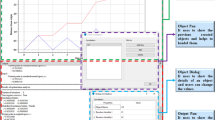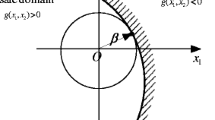Abstract
A multibody system can be modeled with multiple parameters such as mass, stiffness, damping, and length. Even though such parameters are frequently assumed to be deterministic, they are not because of various factors such as manufacturing tolerance, material irregularity, fatigue, and wear. Because the performance of a multibody system depends on its parameters, parameter uncertainties result in system performance uncertainty. Probability density functions (PDFs) of uncertain parameters can be identified based on their populations. In practical engineering problems, however, it is almost impossible to enumerate the populations of all parameters. Therefore in this study, we propose a sample-based reliability design method using an extreme value theory. The effectiveness and accuracy of the proposed method is validated with three explicit functions and two multibody systems.



























Similar content being viewed by others

References
Ulam, S., Richtmyer, R.D., Von Neumann, J.: Statistical methods in neutron diffusion. Los Alamos Scientific Laboratory report LAMS-551 (1947)
Shinozuka, M.: Basic analysis of structural safety. J. Struct. Eng. 109(3), 721–740 (1983)
Breitung, K.: Asymptotic approximations for multinormal integrals. J. Eng. Mech. 110(3), 357–366 (1984)
Hasofer, A.M., Lind, N.C.: Exact and invariant second-moment code format. J. Eng. Mech. Div. 100(1), 111–121 (1974)
Seo, H.S., Kwak, B.M.: Efficient statistical tolerance analysis for general distribution using three-point information. Int. J. Prod. Res. 40(4), 931–944 (2002)
Rahman, S., Xu, H.: A univariate dimension-reduction method for multi-dimensional integration in stochastic mechanics. Probab. Eng. Mech. 19(4), 393–408 (2004)
Youn, B.D., Zhimin, X., Wang, P.F.: Eigenvector dimension-reduction (EDR) method for sensitivity-free probability analysis. Struct. Multidiscip. Optim. 37(1), 13–28 (2008)
Sandu, A., Sandu, C., Ahmadian, M.: Modeling multibody dynamic systems with uncertainties. Part I. Theoretical and computational aspects. Multibody Syst. Dyn. 23, 375–395 (2006)
Sandu, A., Sandu, C., Ahmadian, M.: Modeling multibody dynamic systems with uncertainties. Part II. Numerical applications. Multibody Syst. Dyn. 22, 241–262 (2006)
Naets, F., Tamarozzi, T., Desmet, W.: A system level model reduction approach for flexible multibody systems with parametric uncertainties. Proc. IUTAM. 13, 4–13 (2015)
Kim, B.S., Eom, S.M., Yoo, H.H.: Design variable tolerance effects on the natural frequency variance of constrained multi-body systems in dynamic equilibrium. J. Sound Vib. 320, 545–558 (2009)
Batou, A., Soize, C.: Rigid multibody system dynamics with uncertain rigid bodies. Multibody Syst. Dyn. 27, 285–319 (2012)
Batou, A., Soize, C., Choi, C.K., Yoo, H.H.: Robust design in multibody dynamics—application to vehicle ride-comfort optimization. Proc. IUTAM. 13, 90–97 (2015)
Jaynes, E.T.: Information theory and statistical mechanics. Phys. Rev. 106(4), 620–630 (1957)
Jaynes, E.T.: Information theory and statistical mechanics. Phys. Rev. 108(2), 171–190 (1957)
Shannon, C.E.: A mathematical theory of communication. Bell Syst. Tech. J. 27, 379–423 (1948) and 623–659
Zhang, R., Mahadevan, S.: Model uncertainty and Bayesian updating in reliability-based inspection. Struct. Saf. 22, 145–160 (2000)
Youn, B.D., Wang, P.F.: Bayesian reliability-based design optimization using eigenvector dimension reduction (EDR) method. Struct. Multidiscip. Optim. 36, 107–123 (2008)
Castillo, E.: Extreme Value Theory in Engineering. Academic Press, New York (1988)
Rao, S.S.: Reliability-Based Design. McGraw-Hill, New York (1992)
Castillo, E., Hadi, A.S., Balakrishnan, N., Sarabia, J.M.: Extreme Value and Related Models with Applications in Engineering and Science. Wiley, New Jersey (2005)
Fisher, R., Tippett, L.: Limiting forms of the frequency distribution of the largest or smallest member of a sample. Proc. Camb. Philos. Soc. 24, 180–190 (1928)
Gnedenko, B.: Sur la distribution limite du terme maximum d’une série aléatoire. Ann. Math. 44, 423–453 (1943)
Jenkinson, A.F.: The frequency distribution of the annual maximum (or minimum) of meteorological elements. Q. J. R. Meteorol. Soc. 81(348), 158–171 (1955)
Prescott, P., Walden, A.T.: Maximum likelihood estimation of the parameters of the generalized extreme-value distribution. Biometrika. 67(3), 723–724 (1980)
Hosking, J.R.M.: L-moments: analysis and estimation of distributions using linear combinations of order statistics. J. R. Stat. Soc. B 52(1), 105–124 (1990)
Madsen, H., Rasmussen, P.F., Rosbjerg, D.: Comparison of annual maximum series and partial duration series methods for modeling extreme hydrologic events. 1. At-site modeling. Water Resour. Res. 33(4), 747–757 (1997)
Hook, R., Jeeves, T.A.: Direct search solution of numerical and statistical problems. J. ACM 8(2), 212–229 (1961)
Lewis, R.M., Torczon, V.: A globally convergent augmented Lagrangian pattern search algorithm for optimization with general constraints and simple bounds. SIAM J. Optim. 12(4), 1075–1089 (2002)
Schiehlen, W., Eberhard, P.: Applied Dynamics. Springer, Berlin (2014)
Choi, D.H., Park, J.H., Yoo, H.H.: Modal analysis of constrained multibody system undergoing rotational motion. J. Sound Vib. 280, 63–76 (2005)
Griffin, M.: Vertical vibration of seated subject: effects of posture, vibration level and frequency. Aviat. Space Environ. Med. 46(3), 269–276 (1975)
Parsons, K., Griffin, M.: The effect of rotational vibration in roll and pitch axes on the discomfort of seated subjects. Ergonomics 21(8), 612–625 (1978)
ISO: Mechanical vibration and shock evaluation of human exposure to whole body vibration, Part 1: General requirements. International Organization for Standardization ISO 2631-1, Geneva (1997)
Acknowledgement
This research was supported by the National Research Foundation of Korea (NRF) funded by the Ministry of Education, Science and Technology (MEST) of Korea (Grant number: NRF-2015R1A2A2A01003422).
Author information
Authors and Affiliations
Corresponding author
Rights and permissions
About this article
Cite this article
Choi, C.K., Batou, A. & Yoo, H.H. Reliability design of multibody systems using sample-based extreme value theory. Multibody Syst Dyn 37, 413–440 (2016). https://doi.org/10.1007/s11044-015-9482-7
Received:
Accepted:
Published:
Issue Date:
DOI: https://doi.org/10.1007/s11044-015-9482-7



